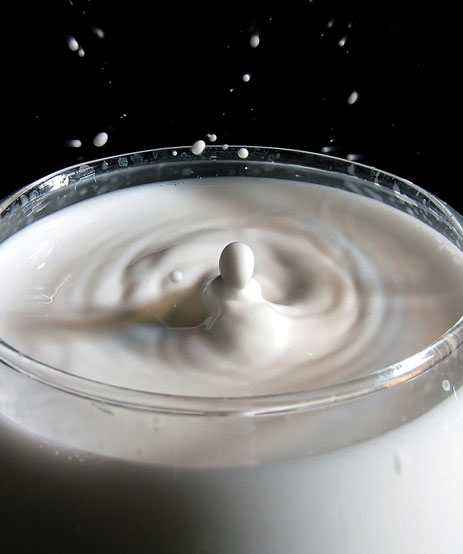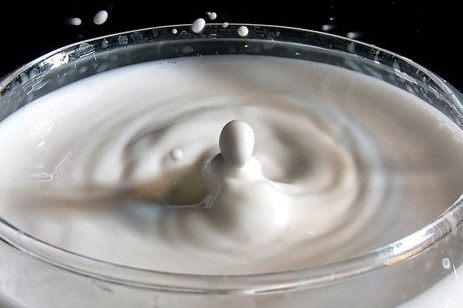 Photo: Guiri R. ReyesUpdated 11 a.m. and 1:30 p.m. Oct. 6
Photo: Guiri R. ReyesUpdated 11 a.m. and 1:30 p.m. Oct. 6
Earlier this week, the Sixth Circuit Court of Appeals overturned the state of Ohio’s ban on labels that identify milk as rBST- or rBGH-free, meaning produced without the use of artificial bovine growth hormone. Consumer and organic food groups were jubilant at the Ohio news, which may have far-reaching repercussions not only for all milk, but for genetically engineered foods.
First, some background: rBGH stands for recombinant bovine growth hormone; rBST for recombinant bovine somatotropin. Both are a genetically engineered variation on naturally occurring hormone that farmers inject into cows to increase milk production by as much as 10 percent. It has also been proven to increase the incidence of mastitis in cows, which as any breastfeeding mother knows is a painful condition requiring treatment by antibiotics — and indeed, rBGH use has also upped the use of antibiotics in dairy cattle.
The United States is the only developed nation to allow people to drink milk from cows given artificial growth hormone. All 27 countries of the European Union, Canada, New Zealand, Australia, and Canada have banned its use in milk destined for human consumption. [Update: Brazil does allow it.] In 2007, Monsanto, which created and manufactured Posilac, the most popular form of rBST, began encouraging its dairy-farmer customers to protest their rBGH-free competitors’ labeling. Campaigns to restrict rBGH-free labeling were launched in 14 states, as this Ethicurean satire chronicled, but only Ohio passed the effort. In October 2008, Monsanto saw the writing on the dairy wall and dumped Posilac on Eli Lilly.
Thanks to consumer pressure, approximately 60 percent of milk in the U.S. is rBST-free at this point, labeled or not, according to the Center for Food Safety. However, that leaves an enormous amount of milk still being produced with these hormones, and by extension cheese and most brands of ice cream, except for Ben & Jerry’s.
Pus budget
The joyful reception to the appeals court’s decision is about more than the right of consumers to know what’s in their food — something that may come in handy in the fight over labeling for genetically modified foods such as the new salmon. Much of the appeals court’s rationale hinged on its assertion that there is a “compositional difference” between milk produced using the hormones and milk produced without. While the district court denied this fact, the appeals court stated very clearly that such a denial “is belied by the record.”
As Jill Richardson helpfully summarized it, compared to untreated milk, rBST milk has:
- Increased levels of the cancer-causing hormone IGF-1 [more about that in this report from the watchdog group Consumer Union]
- Lower nutritional quality when produced at certain points in the cow’s lactation cycle; and
- Increased somatic cell counts (i.e. more pus in the milk)
The court’s decision notes that those higher somatic cell counts “make the milk turn sour more quickly and is another indicator of poor milk quality.”
While the “compositional difference” debate may seem to be semantic wrangling (although that “pus” mention sure is eye-catching!), the appeals court’s determination suddenly and unexpectedly undercuts the FDA’s entire rationale for allowing the sale of unlabeled rBST milk for human consumption. As with many technological processes, the FDA relies on the fact that the end product, whether it be milk or genetically engineered fish, is indistinguishable in all detectable ways from its conventionally produced counterpart.
For many, like Center for Food Safety attorney George Kimbrell, who coauthored the amicus brief on which the appeals court drew for its ruling, the court’s conclusion was a surprise. He told me that going into the appeal, he had thought it “highly unlikely” that the appeals court would address the issue directly, since neither party to the lawsuit brought it up during the underlying case. For him, it’s this aspect that makes the ruling truly groundbreaking.
He also observed that the FDA has not addressed the issue in a long time. “Perhaps it is time for FDA to go back and make a new determination about the differences in milk,” said Kimbrell.
True — or false and misleading?
What will the FDA do now? According to FDA spokesperson Siobhan DeLancey, Probably nothing. [An editing error previously mischaracterized my analysis of the FDA’s probable inactivity as coming from its spokesperson.]
In an email exchange, FDA spokesperson Siobhan DeLancey sent me an excerpt of the current FDA rBST labeling guidelines, which date back to 1994. In it, the FDA allows producers to label milk voluntarily, but clearly doesn’t like it when they do:
FDA is concerned that the term “rbST free” may imply a compositional difference between milk from treated and untreated cows rather than a difference in the way the milk is produced. Without proper context, such statements could be misleading. Such unqualified statements may imply that milk from untreated cows is safer or of higher quality than milk from treated cows. Such an implication would be false and misleading.
She did assure me, however, that, “If the FDA becomes aware of scientific evidence that there is a compositional difference between the two types of milk, it will reevaluate at that time.”
Hmm. Wait a minute. Isn’t that what just happened?
I pointed out to her that the appeals court had just established exactly what the FDA claims has not been established, that rBST-free milk “is safer or of higher quality than milk from treated cows” and referred to reams of data indicating just that. So is the agency going to reevaluate?
The FDA had no comment.
Well, glad we cleared that up. In fairness, the agency has not yet had a chance to review the Ohio ruling. Of course, a consumer group could petition the FDA and demand a reevaluation of rBST milk, so that it — and not its artificial hormone-absent counterpart — would have to be the one labeled. Indeed, there would be no small irony in Monsanto’s campaign to expand the production of rBST-produced milk leading to mandatory labeling for it, much less establishing legal precedent to support labeling of genetically modified foods — the cornerstone of Monsanto’s business — which some advocates say this ruling provides.
And what of the concern that Monsanto will simply push the state of Ohio to appeal the appeal all the way to the Supremes? Well, the Center for Food Safety’s Kimbrell thinks the chances of a successful further appeal are dim. “The bar
is set very high” at this point in the process, he said, and success requires finding “big errors of law… either statutory or constitutional in nature” which this decision simply does not have.
Even so, until and unless someone demands the FDA act in response to this ruling, the appeals court yet may find its most surprising and groundbreaking finding quietly ignored.



